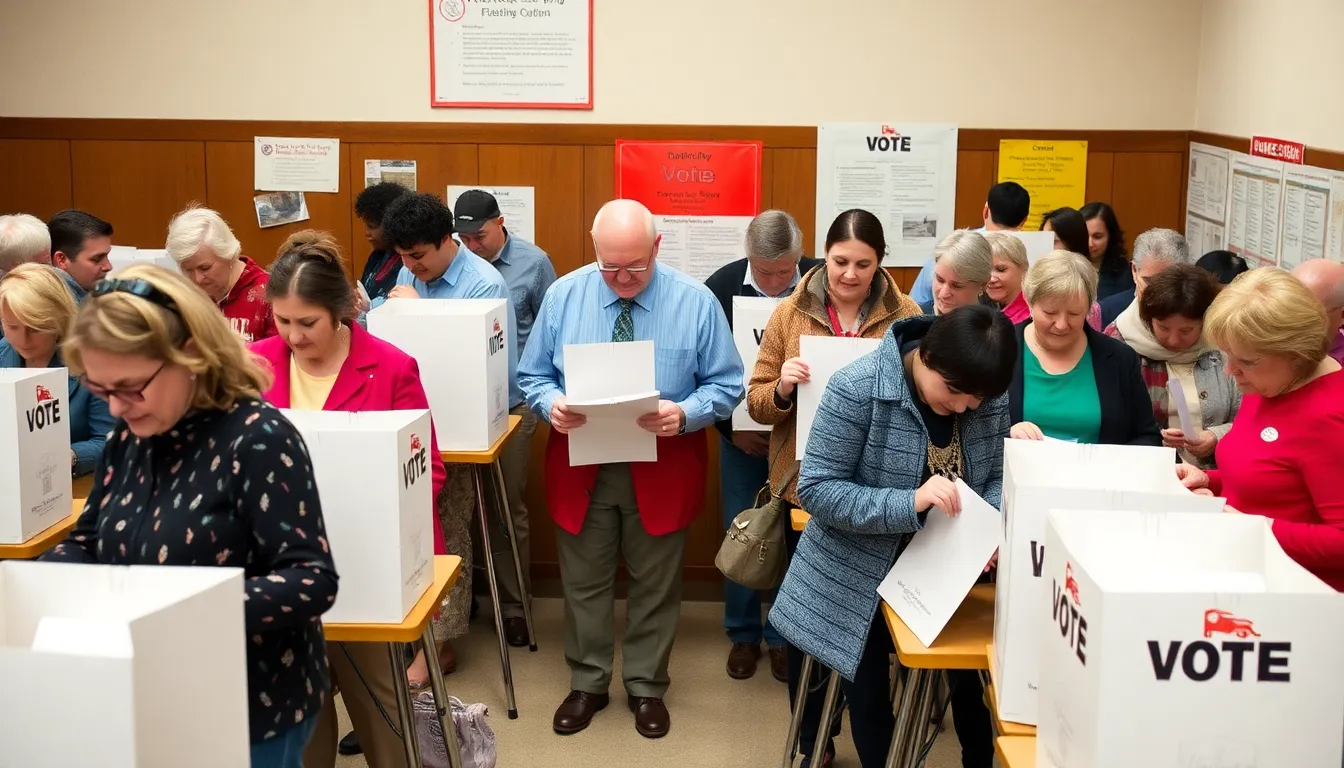Ohio, the Buckeye State, often finds itself at the center of political debates. Is it a red state, a blue state, or just a state that can’t decide what color it wants to wear today? With its rich history of swing voting, Ohio has been the bellwether for presidential elections, leaving many scratching their heads over its political identity.
From the bustling streets of Columbus to the serene shores of Lake Erie, Ohio showcases a diverse population with varying political beliefs. It’s a place where you might find a farmer in overalls chatting with a tech guru in a hoodie, both passionately defending their views. So, is Ohio leaning red or blue? Buckle up as we dive into the political landscape of this fascinating state and uncover the truth behind its vibrant electoral tapestry.
Table of Contents
ToggleOverview of Ohio’s Political Landscape
Ohio’s political landscape is marked by a blend of ideologies. Political affiliations in Ohio span a range of beliefs, showcasing the state’s character as a battleground. Historically, it has voted for both Democratic and Republican candidates in presidential elections. The state’s status as a swing state originates from its competitive electoral environment, which reflects diverse demographics and interests.
Urban areas like Columbus and Cleveland lean Democratic. Conversely, rural regions often support Republican candidates. This division illustrates the varied socio-economic factors influencing voters across the state. Census data indicates that about 12 million people live in Ohio, contributing to this multifaceted political climate.
In recent elections, Ohio voted for Republican candidates in 2016 and 2020 presidential races. Significant voter engagement occurs during midterm elections, with critical statewide positions often contested. A close look at local elections reveals shifting party loyalties, particularly among independent voters.
Polling data reflects that around 40% of Ohio voters identify as independent, complicating the state’s classification as strictly red or blue. Engagement in civic activities such as community forums and debates also shapes voter perspectives. The shifting demographics, influenced by factors such as education and economic conditions, further complicate the state’s political identity.
Ohio embodies a dynamic political landscape marked by historical significance and evolving voter preferences. This complexity reflects the ongoing dialogue among Ohioans about their political priorities and affiliations.
Historical Voting Trends

Ohio has a storied history of voting patterns that reflect its political complexity. Significant trends emerge when examining presidential and state elections.
Presidential Elections
In presidential elections, Ohio has acted as a bellwether since the late 19th century. The state voted for the winning candidate in 29 of the last 30 elections. Republican candidates gained momentum in recent elections, capturing Ohio’s electoral votes in 2016 and 2020. However, Democrats previously found success in 2008 and 2012, indicating shifting allegiances. Voter turnout remains high, often exceeding 70% during presidential years. The engagement of independent voters, which comprises nearly 40% of the electorate, plays a critical role in outcomes. These dynamics underscore Ohio’s unpredictability during national races.
State Elections
Ohio’s state elections reflect similar fluctuations. Historically, both Democratic and Republican candidates have governed the state. Recent elections show a Republican stronghold, with major offices held by GOP candidates since 2010. However, Democratic gains in urban areas like Columbus and Cleveland challenge this dominance. Voter participation in state elections averages around 45%, which influences outcomes significantly. Additionally, local issues often sway voter preferences, complicating party alignment. The duality of Ohio’s political landscape emerges clearly in its state-level contests.
Key Demographics Influencing Political Leanings
Demographics play a vital role in shaping Ohio’s political landscape. Variations between urban and rural populations contribute significantly to voting behavior.
Urban vs. Rural Areas
Urban areas display distinct political leanings compared to rural regions. Cities like Columbus and Cleveland typically lean Democratic with their younger and more diverse populations. Suburban communities sometimes mirror these trends but may also show mixed voting patterns. Rural areas, on the other hand, often support Republican candidates, influenced by conservative values and agricultural interests. The divide between these areas illustrates how geography affects voter preferences, creating a blend of ideologies that defines Ohio’s electorate.
Education and Economic Factors
Educational attainment influences voting behavior significantly in Ohio. Higher education levels correlate with Democratic support, particularly in urban centers. Job sectors also impact political choices; industries like technology and healthcare lean Democratic due to progressive policies. Conversely, regions dependent on manufacturing or agriculture often favor Republican candidates, valuing traditional economic structures. Economic stability shapes voters’ priorities, as those in prosperous areas may advocate for different policies than those facing economic hardships.
Recent Election Results
Ohio’s recent election outcomes highlight its dynamic political landscape and swinging voter preferences.
2020 Presidential Election
In the 2020 presidential election, Donald Trump received 53.3% of the votes while Joe Biden garnered 45.2%. Trump’s support represented a continuation of Republican strength in Ohio, reflecting the state’s conservative leanings in rural areas. Urban centers like Columbus and Cleveland played a crucial role in Biden’s numbers, albeit not enough to secure a win. Nearly 5.9 million voters cast their ballots, showcasing a turnout rate of about 75%. Independent voters significantly influenced the results, as they comprised nearly 40% of the electorate, demonstrating their pivotal role in shaping Ohio’s political future.
2022 Midterm Elections
During the 2022 midterm elections, Republicans maintained a stronghold in Ohio, winning key statewide offices. Mike DeWine, the incumbent governor, received 53.2% of the vote compared to his Democratic challenger, who obtained 42%. Voter turnout dipped to around 45%, yet issues like inflation and crime remained dominant themes influencing choices. Both chambers of the Ohio General Assembly continued under Republican control, reinforcing the party’s influence. Urban areas emerged as crucial battlegrounds, with Democrats making some gains, particularly among younger voters. These shifts indicated a complex, evolving relationship between demographics and party alignment in the state.
Analysis of Political Parties in Ohio
Ohio’s political landscape reflects a blend of conservative and liberal ideologies, impacting local and national elections.
Republican Party Influence
Republicans maintain a strong presence in Ohio, especially in rural areas. Approximately 53.3% of voters supported Donald Trump in 2020, underscoring this influence. Since 2010, Republican candidates have dominated state-level offices, with Mike DeWine winning the governorship in 2022 with 53.2% of the votes. The party’s appeal often stems from its emphasis on traditional values and economic stability, resonating with many voters outside urban centers. At the grassroots level, local GOP organizations actively mobilize voters, fostering community engagement. Rural voters, driven by agricultural interests, frequently align with Republican candidates, reinforcing the party’s strength in these regions.
Democratic Party Strategies
Democrats focus on urban areas like Cleveland and Columbus, employing strategies that resonate with younger, diverse populations. In the 2020 presidential election, Joe Biden secured 45.2% of the vote, showcasing urban influence despite Republican strength. Engaging independent voters remains crucial, as around 40% of Ohio residents identify as such. Democratic campaigns often center on issues like healthcare, education, and social justice to attract these voters. Gaining support among younger demographics also plays a vital role, particularly in urban settings where progressive policies are more appealing. Urban Democratic parties partner with grassroots organizations to amplify voter turnout in elections, aiming to turn battlegrounds into strongholds.
Ohio’s political landscape remains a fascinating blend of red and blue influences. Its status as a swing state underscores the importance of independent voters and the significant impact of urban versus rural dynamics. With a history of supporting both major parties in presidential elections, Ohio exemplifies the complexities of American politics.
As demographics shift and voter priorities evolve, the state’s political identity will continue to be shaped by civic engagement and local issues. Whether leaning Republican or Democratic in specific elections, Ohio’s electorate reflects a diverse range of beliefs and values that make it a critical player in national politics. The ongoing dialogue among Ohioans about their political affiliations ensures that the state’s role in future elections will be just as pivotal.



